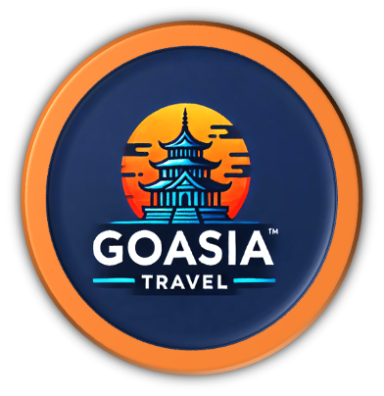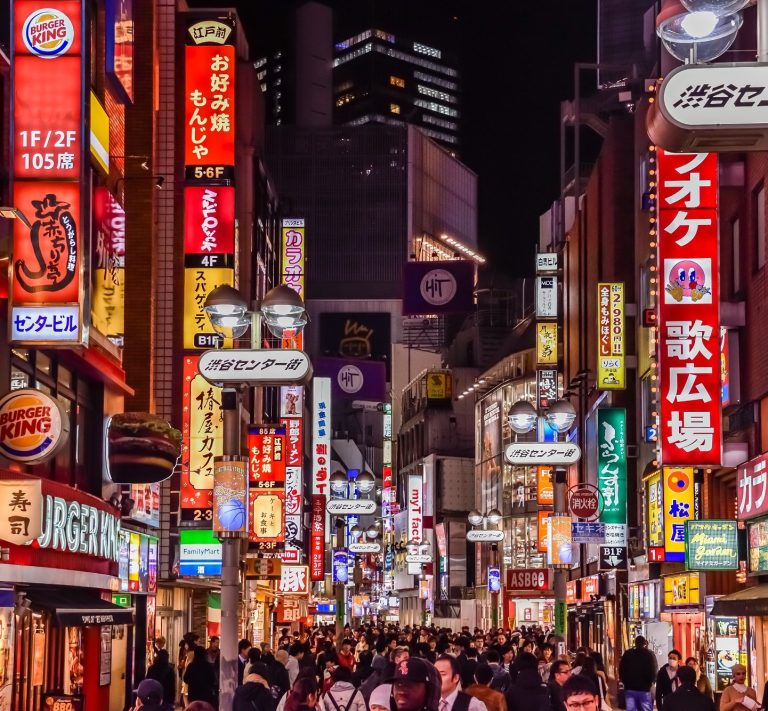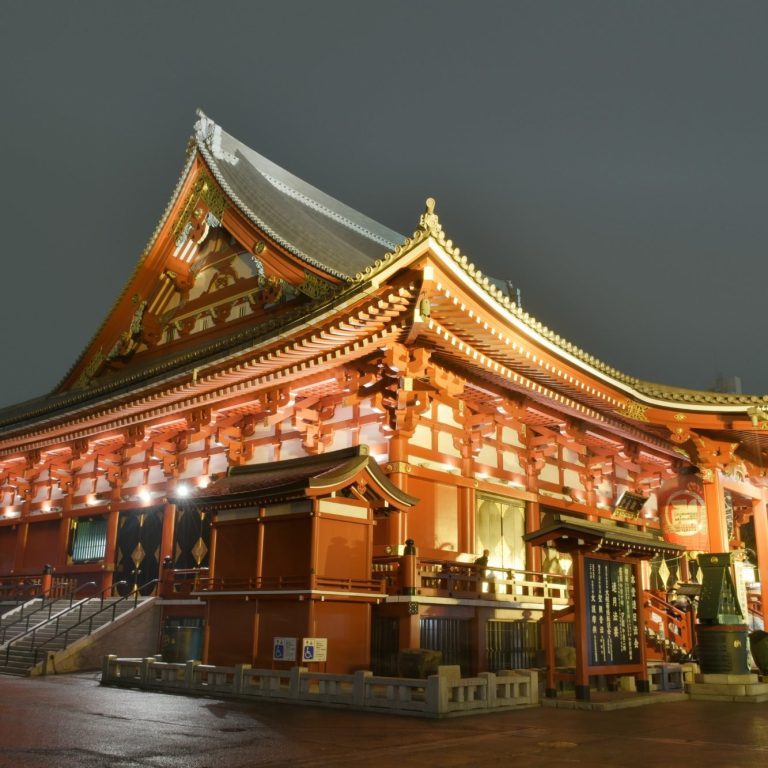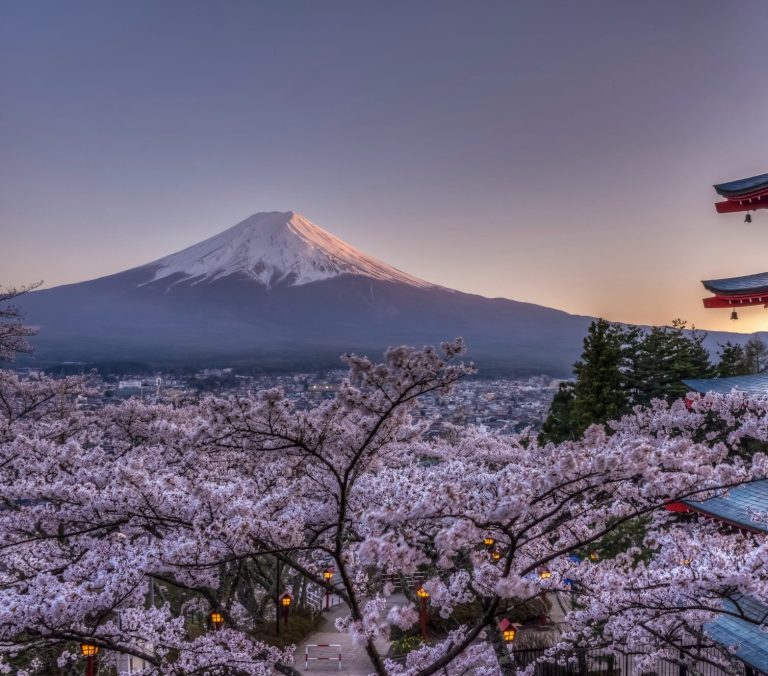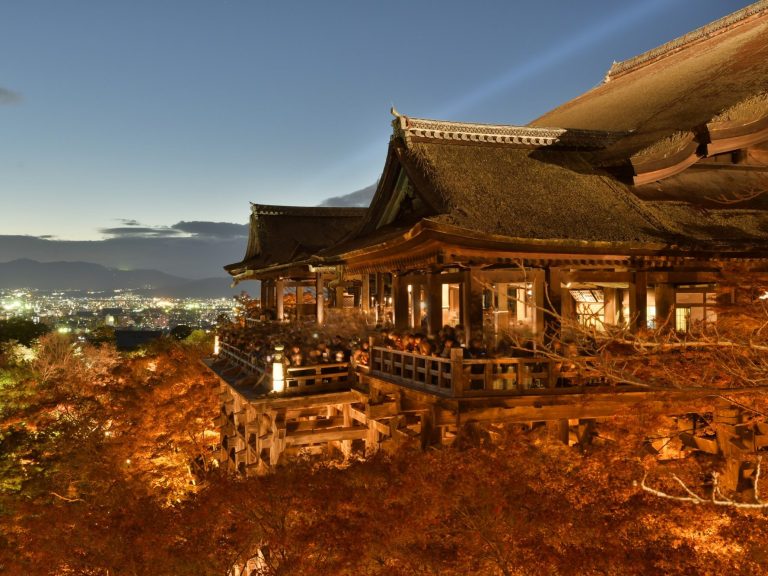Best of Japan
14 Days/13 Nights
Overview
On this two-week tour, you’ll explore Japan, visiting some of the most historically and culturally significant locations the country has to offer. Discover famous sites such as the picturesque traditional village of Shirakawago and the Itsukushima Shrine’s iconic torii gate, which appears to float above the water during high tide.
Tour at a Glance
Day 1: Tokyo
Arrive in Tokyo and enjoy the city at your leisure. Explore peaceful gardens, shrines, and vibrant districts like Shinjuku and Asakusa.
Day 2: Tokyo
Take a guided tour to Asakusa's Sensoji Temple, enjoy a boat ride on the Sumidagawa River, and visit Meiji Shrine and Omotesando for modern shopping and architecture.
Day 3: Tokyo
Explore Tsukiji Outer Market and sample fresh seafood, followed by a private sushi cooking class where you make and enjoy your own sushi.
Day 4: Tokyo – Hakone/Mt. Fuji
Travel to Hakone by bullet train, enjoy scenic views of Mt. Fuji, and stay in a traditional ryokan with onsen (hot spring) baths.
Day 5: Hakone – Takayama
Travel to Takayama via Nagoya, a town rich in culture and traditions. Visit a local sake brewery or explore the historic San-machi Suji district.
Day 6: Takayama
Leisure day to visit Miyagawa Morning Market, the Hida No Sato Folk Village, or the Takayama Festival Floats Museum.
Day 7: Takayama – Kanazawa via Shirakawago
Visit Shirakawago’s UNESCO-listed gassho-zukuri village, then head to Kanazawa to explore its traditional districts and modern attractions.
Day 8: Kanazawa
Explore Kenrokuen Garden, Kanazawa Castle, and the Nagamachi Samurai District at your own pace.
Day 9: Kanazawa – Hiroshima
Travel to Hiroshima, known for its peace memorials. Spend the afternoon exploring the city at leisure.
Day 10: Hiroshima – Miyajima – Hiroshima
Visit Hiroshima Peace Memorial Park and then ferry to Miyajima Island to see the iconic Floating Torii Gate and ancient shrines.
Day 11: Hiroshima – Kyoto
Travel to Kyoto, Japan's cultural heart. Enjoy a cooking class and learn to prepare traditional kappo cuisine.
Day 12: Kyoto
Visit Kyoto’s top World Heritage Sites, including Kinkakuji Temple, Nijo Castle, and Nishiki Market. Explore the historic sites like Kiyomizu Temple or Sanjusangendo.
Day 13: Kyoto – Nara & Fushimi
Visit Nara’s Todaiji Temple and Kasuga Taisha Shrine, then head to Fushimi Inari Shrine with its famous torii gates. End the day at a local sake brewery.
Day 14: Kyoto – Tokyo – Depart
Free day in Kyoto before traveling to Tokyo Narita Airport for your departure.
Detailed Itinerary
Day 1: Tokyo
Tokyo is a city of contrasts. This front-line capital famous for its pioneering modernity, iconic landscapes of neon and soaring skyscrapers is dotted with peaceful parklands, shrines, temples, and adored gardens. Despite its mania for anime pop culture, fashion, digital trends and discernable consumption, the city embraces an ancient heritage evident in the temples and shrines scattered amongst the vast sky rises. The Imperial Palace provides a palpable link to the city’s incredible heritage even with the explosion of commercial emporia. Free from the shopping and entertainment districts, historic wooden house, private bonsai gardens and the calming Zen atmosphere of the Hamarikyu Gardens thrive to allow visitors an escape from the hyperactivity of the lively streets. Even with the city’s costly reputation visitors can take advantage of the inexpensive izakaya bars and neighbourhood cafes serving delectable noodle and rice dishes. In fact, many of Tokyo’s charms can be enjoyed free of charge; stroll through Asakusa and the Buddhist temple Sensoji, the fashion Mecca of Harajuku, the world’s largest fish market at Tsukiji, or the neon-imbued atmosphere of Shinjuku and be enveloped by Japan’s largest city.
On your arrival at Narita Airport, you will be met by an assistant at the arrival lobby for your shared transfer to your hotel in Tokyo.
Upgrade to Private Airport Transfer (price in JPY, per pax)
You will have the rest of the day to spend at your leisure after check-in.
Meals included: None
Guiding: Meet and greet only
Accommodation: Standard Grade Hotel: Shiba Park Hotel
Superior Grade Hotel: Park Hotel Tokyo
Day 2: Tokyo
Take a day tour of this fascinating city with a local guide. First up is Asakusa, Tokyo’s old town where you can soak in the atmosphere of the Tokyo of old. Visit Sensoji, Tokyo’s oldest temple and wander down Nakamise, a shopping street that has been providing temple visitors with a variety of traditional, local snacks and tourist souvenirs for centuries. Next, travel down the Sumidagawa River on Tokyo's Water Bus, a unique means of transportation. You'll arrive directly at Hamarikyu garden, an Edo Period Japanese garden surrounded by the Shiodome district’s futuristic skyscrapers, a great example of how Japan is the land of contrasts, where you will stop for a cup of steaming matcha and Japanese sweets in a tea house on a small island in the park’s lake.
After lunch, enjoy a visit to Meiji Shrine, a shrine dedicated to the deified spirit of Emperor Meiji and a popular place for traditional Japanese weddings. Finally, as the sunlight dims, take a walk down the sparkly Omotesando shopping street, a broad tree lined avenue home to the flagship stores of the world’s top fashion brands and some fantastic modern architecture.
Optional tour upgrade for tour by private car.
Meals included: Breakfast
Guiding: 8 hours
Accommodation: Standard Grade Hotel: Shiba Park Hotel
Superior Grade Hotel: Park Hotel Toky
Day 3: Tokyo
Today, you will enjoy a fantastic private cooking lesson. Make your own way to the meeting point, which is the iconic Tsukiji Honganji Temple.
The world’s largest fish market, Tsukiji Market, handled about 2,888 tons of marine products a day worth about 2.8 billion yen (US$20million) before half of it moved to its new location in Toyosu. Some 450 kinds of fish were received – from penny-per-piece sardines to golden brown dried sea slug caviar, a bargain at US$473 a pound. Some of the giant tuna sold for well over 1,000,000JPY each (US$8000). While the inner market has moved to its new location, the outer market remains standing and you can take time to wander through, exploring both the vegetable and fruit areas plus the impressive seafood section. You will stroll around the market with a guide and will be able to try some tasty samples as you explore.
You will then hop on a local bus to visit a nearby Japanese chef. He will answer all your questions about sushi and Japanese food culture and will help you to make a selection of delicious fresh sushi. You will then get to enjoy your home-made sushi for lunch.
Please note that this tour focuses on the outer market open to the public at Tsukiji and not the new inner market located at Toyosu.
Note: Due to closures at the market, this tour is not available on Sundays or Wednesdays. We would be happy to suggest an alternative cooking class or tour on these dates.
Meals included: Breakfast, Lunch
Guiding: 4 hours
Accommodation: Standard Grade Hotel: Shiba Park Hotel
Superior Grade Hotel: Park Hotel Tokyo
Day 4: Tokyo-Hakone/Mt Fuji
Hakone is a natural wonderland and is famous for its hot springs, outdoor pursuits, and the view of the nearby Mount Fuji. It is part of the Fuji-Hakone-Izu National Park and is less than 100-km from Tokyo, providing a popular weekend destination for city residents keen to escape the frenzy of the capital. Besides the towering mountains, lakes, and views of Mount Fuji, it is also blessed with charming historical sites. Beautiful Hakone has just about everything a vacationer could wish for.
Take Japan’s world-famous Shinkansen bullet train to Hakone,(2hr) using your JR Pass. Armed with your Hakone Free Pass, take advantage of the extensive local transport network to explore this stunning region (unguided). From switchback trains to cable cars, ropeways to buses and even a pirate ship that will sweep you across the volcanic Lake Ashi with views of Mt Fuji.
Tonight, you will stay in a Japanese traditional ryokan, sleeping on futons laid out on tatami mats with delicious, included meals and piping hot onsen (hot spring) baths.
Optional Station Transfer:
We can arrange a transfer for you to the station should you prefer. This is especially a great option for those who have heavy luggage.
- Tokyo Hotel to Tokyo Station Transfer by Taxi
- Tokyo Hotel to Tokyo Station Transfer by Private Car
- Odawara Station to Hakone Hotel Transfer by Private Car
Meals included: Breakfast and Dinner
Guiding: None
Accommodation: Standard Grade Hotel: Ichinoyu Honkan (Japanese room, toilet but no bath)
Superior Grade Hotel: Susukinohara Ichinoyu (Outdoor hot spring bath)
Day 5: Hakone-Takayama
With its plethora of temples, shrines, festivals, rivers and bridges the mountain town of Takayama has been called a “little Kyoto”. The region is an agricultural one, and every day the freshest of vegetables and fruit are brought by local farmers to Takayama’s lively morning market. Many unique traditions have evolved here, and due to the town’s previously inaccessible location high in the Hida alpine region, a remarkable number of them have been preserved. The district called San-machi Suji, the traditional home of Takayama merchants and sake brewers, has been preserved in almost the same state as 200 or 300 years ago. Here, are inns, shops and taverns which trace their history back many generations.
From Hakone, take the world-famous Shinkansen bullet train to Nagoya, reaching speeds of up to 300 km/h. Journey time is around 2hrs. You will then change at Nagoya onto the Limited Express Hida Wideview for one of the most scenic train journeys in Japan, winding your way through tall mountains and stunning gorges to Takayama. This is a long journey of around 2.5 hours, but worth it for the scenery.
Upon arrival, make your own way to your accommodation. This afternoon we recommend visiting one of the town’s many sake breweries for a taste of the local drop, its high quality ingrained in the area’s clean water sources.
Meals included: Breakfast
Guiding: None
Accommodation: Standard Grade Hotel: Sumiyoshi
Superior Grade Hotel: Hidatei Hanaougi
Day 6: Takayama
The day is at your leisure.
Suggestion:
After breakfast, we recommend you head up to the Miyagawa morning markets which sell local crafts and produce. This is a great opportunity to try some of the region’s delicious fruit and vegetables. A short bus ride will take you to Hida No Sato Folk Village, an open-air museum exhibiting over 30 typical farmhouses and other traditional buildings from the Hida region. A workshop in the village illustrates how many of Japan's famous handicrafts are made, including wood carving, tie-dying, weaving, and lacquering. In the afternoon, you can visit the Takayama Festival Floats Museum, displaying floats from the famous Takayama festival, or simply wander through the beautifully preserved old town.
Meals included: Breakfast
Guiding: None
Accommodation: Standard Grade Hotel: Sumiyoshi
Superior Grade Hotel: Hidatei Hanaougi
Day 7: Takayama-Kanazawa-Shirakawago
Today will be self-guided. Using your included coach tickets, which you can use to board the bus from Takayama Bus Terminal (next to the station), you will pay a visit to the UNESCO World Heritage Listed Shirakawago village, famous for its traditional gassho-zukuri farmhouses, some of which are more than 250 years old. Journey time to Shirakawago is around 1.5 hours.
Gassho-zukuri translates as ‘Praying Hands’, as the farmhouses' steep thatched roofs resemble the hands of Buddhist monks pressed together in prayer and are designed to withstand the heavy snows which fall in the region.
After your visit, you will head onwards to Kanazawa by coach with your included ticket (around 1 hour).
Optional Station Transfers:
- Kanazawa Station to Kanazawa Hotel Transfer by Private Car
Meals included: Breakfast
Guiding: None
Accommodation: Standard Grade Hotel: Hotel Vista Kanazawa
Superior Grade Hotel: ANA Crowne Plaza Kanazawa
Day 8: Kanazawa
During the Edo Period, Kanazawa served as the seat of the Maeda Clan, the second most powerful feudal clan after the Tokugawa in terms of rice production and fief size. Accordingly, Kanazawa grew to become a town of great cultural achievements, rivalling Kyoto and Edo (Tokyo). During World War Two, Kanazawa was Japan's second largest city (after Kyoto) to escape destruction by air raids. Consequently, parts of the old castle town, such as the Nagamachi samurai district and chaya entertainment districts, have survived in good condition. Today, Kanazawa remains an important city in its region and serves as the capital of Ishikawa Prefecture. The city boasts many historical attractions such as restored residences and districts, as well as modern museums. But Kanazawa's unchallenged main attraction is Kenrokuen, one of Japan's "three best landscape gardens" and by many considered the most beautiful of them all.
A free day to explore Kanazawa.
Suggestion:
The highlight of any visit to Kanazawa is Kenrokuen garden – its breath-taking beauty shines through in any season. We also recommend visiting Kanazawa Castle, located next to the garden. You can visit the Nagamachi Samurai District, the Saihitsuan Yuzen Silk Center – demonstrating the centuries-old Yuzen silk painting technique – and the Nomura Samurai House – a traditional Japanese home with a tea-ceremony room, an interior courtyard garden and artifacts from the Edo period.
Meals included: Breakfast
Guiding: None
Accommodation: Standard Grade Hotel: Hotel Vista Kanazawa
Superior Grade Hotel: ANA Crowne Plaza Kanazawa
Day 9: Kanazawa-Hiroshima
Hiroshima is notorious for its destruction when the first Atomic Bomb was dropped over the city during the Second World War in August 1945. The destructive power of the bomb obliterated nearly everything within a two-kilometre radius. From this absolute annihilation, Hiroshima emerged, phoenix-like, and become a beacon of hope and peace for the rest of mankind. Destroyed monuments of the city’s historical heritage, such as the Shukkeien Garden and the Hiroshima Castle, have been rebuilt. The city centre boasts a large recreational area named Peace Memorial Park, reflecting the aspirations of this reborn city. The city’s tragic past has become its biggest tourism attraction, and visitors from around the world now come to see the Peace Memorial Park and its haunting museum. Hiroshima is now the principal city of the Chugoku region and is home to over a million inhabitants who live in a municipality that boasts wide tree-lined boulevards and rivers.
Besides excellent museums, Hiroshima is also the most popular gateway for trips to nearby Miyajima, an island considered to be one of Japan’s most scenic spots.
Travel by train to Hiroshima (4 hours with one change in Shin Osaka).
Your afternoon is at your leisure.
Optional Station Transfers:
- Kanazawa Hotel to Kanazawa Station Transfer by Private Car
- Hiroshima Station to Hiroshima Hotel Transfer by Private Car
Meals included: Breakfast
Guiding: None
Accommodation: Standard Grade Hotel: Hotel Vista Hiroshima
Superior Grade Hotel: Hotel Granvia Hiroshima
Day 10: Hiroshima-Miyajima-Hiroshima
Today you will take a day tour of Hiroshima with a local guide, starting with a visit the Hiroshima Peace Memorial Park. The area where the park now lies was ground zero for the Atomic Bomb on 6th August 1945. After the bombing the Memorial Park was created and dedicated to those who lost their lives in the attack. Stroll through the peaceful atmosphere to discover the many memorials, monuments, and statues before heading into the Museum itself.
From Hiroshima, a short ferry ride will take you to Miyajima Island (around 30 mins by ferry). A small sacred island located in the Inland Sea; it has been a holy place of Shintoism since the earliest times. Here you will find the most photographed site in Japan - the Floating Torii Gate. Designated as one of Japan's "Three Most Beautiful Views", the shrine it belongs to dates to the 6th century, with the present structure dating back to the 12th century. The harmoniously arranged buildings reveal great artistic and technical skill and have been designated a UNESCO World Heritage Site. Mere “commoners” were not allowed to set foot on this holy place, and even now it is forbidden to give birth or die on the island!
You will have time to explore the island and its many shrines and temples, sample local cuisine like maple leaf shaped cakes, before heading back to your hotel to relax.
Meals included: Breakfast
Guiding: 8 hours
Accommodation: Standard Grade Hotel: Hotel Vista Hiroshima
Superior Grade Hotel: Hotel Granvia Hiroshima
Day 11: Hiroshima-Kyoto
This is a must-see destination in Japan. Kyoto is the nation’s former capital and was the residence of the emperor from 794 until 1868. It is Japan’s seventh largest metropolis with a population of around 1.4 million and a city of culture that offers a plethora of temples, shrines and other historically priceless structures that still survive today. With 2,000 religious’ buildings, including 1,600 Buddhist temples and 400 Shinto shrines, as well as palaces, gardens and associated architecture, it is one of the best-preserved cities in Japan and has 17 UNESCO World Heritage sites. Kyoto represents the “Japan of old” and beyond the high-rise skyscrapers built as a monument to progress, the real monument to Japan’s historical and cultural past can be found in the city’s narrow alleyways where tea houses abound and kimono-clad geisha hurry from elegant function to function. This is a place to go back in time to Japan’s mysterious past where echoes of the court nobility resonate at the Imperial Palace and the search for contemplation can be found in Ryoanji’s Zen rock gardens.
Back on the Shinkansen as you travel to Kyoto (2hrs, direct).
Optional Station Transfer:
- Hiroshima Hotel to Hiroshima Station Transfer by Private Car
- Kyoto Station to Kyoto Hotel Transfer by Taxi
- Kyoto Station to Kyoto Hotel Transfer by Private Car
In the afternoon, take part in a private cooking lesson.
Japanese cuisine has such a high reputation that it was declared a UNESCO Intangible World Heritage. During this tour you will try your hand at making some of the dishes that made this cuisine so popular around the world and learn about Kyoto’s typical kappo cuisine. In Japanese, “kappo” means to cut ingredients with a knife and cook them over a fire. At a kappo style restaurant, fine seasonal cuisine is served over a counter where you sit face to face with a chef. In this class you will be the chef! (Transfers to and from the cooking school are not included).
Meals included: Breakfast, Dinner
Guiding: 2.5 hours (Cultural experience)
Accommodation: Standard Grade Hotel: Vista Premio Kyoto
Superior Grade Hotel: Granvia Hotel Kyoto
Day 12: Kyoto
Today you explore the former imperial capital with a knowledgeable local guide, utilizing Kyoto’s comprehensive bus system to visit some of Kyoto’s World Heritage Sites. You will start your day with a visit to Kinkakuji Temple (Golden Pavilion), which was originally built as a retirement villa for the Shogun. After his death, it became a Buddhist Temple at his request, and is now one of Kyoto’s most famous temples. Nijo Castle is an ornamental castle built by the founder of the Edo Shogunate as his Kyoto residence and is surrounded by stunning surrounding gardens. The main building was completed in 1603, and is famous for its architecture, decorated sliding doors and ‘chirping’ nightingale floors.
Take a walk down Nishiki Market, a narrow, five block long shopping street lined by more than one hundred shops and restaurants. Known as "Kyoto's Kitchen", this lively retail market specializes in all thing' s food related, like fresh seafood, produce, knives and cookware, and is a great place to find seasonal foods and Kyoto specialties, such as Japanese sweets, pickles, dried seafood and sushi.
To end the day, you can decide what to visit. You may want to go to Kiyomizu (Pure Water) Temple. From the 13m high veranda jutting out from the Main Hall you can enjoy amazing views of the whole of Kyoto, whilst pondering the fact that both the Main Hall and Veranda were built without the use of nails or any kind of joiners; however, it is a steep walk uphill, and the temple is now under repair work, although it is still enjoyable and a Kyoto landmark.
You may decide, instead, to visit Sanjusangendo, a temple which is Japan's longest wooden structure (120m). It is famous for its 1001 statues of Kannon, the goddess of mercy. In the center of the main hall sits a large, wooden statue of a 1000-armed Kannon that is flanked on each side by 500 statues of human sized 1000-armed Kannon standing in ten rows. Together they make for an awesome sight.
Optional tour upgrade for tour by private car
Meals included: Breakfast
Guiding: 8 hours
Accommodation:
Standard Grade Hotel: Vista Premio Kyoto (Standard Room)
Superior Grade Hotel: Granvia Hotel Kyoto (Standard Room)
Day 13: Kyoto-Nara & Fushimi-Kyoto
Head from your hotel to Nara by train (45min) with a local guide. For 74 years during the 8th century, Nara was Japan’s capital and many of the temples and shrines built at that time remain. Visit Todaiji Temple, the world’s largest wooden building and home to Japan’s largest Buddha. Next stop is Nara’s most celebrated shrine, Kasuga Taisha, established in 768 AD and famous for its hundreds of bronze and stone lanterns which have been donated by worshipers.
Take a wander through Nara Park, called Deer Park by locals, home to more than 1,000 tame deer. Before you make your way to Fushimi, you will stop by a Sake Brewery to learn about the production process, as well as sample a few cups for yourself.
Upon returning from Nara, you can visit Fushimi Inari Shrine. The shrine is famous for housing over 10,000 red torii gates, which form a path up the mountain behind the temple.
Optional tour upgrade for tour by private car
Meals included: Breakfast
Guiding: 8 hours
Accommodation:
Standard Grade Hotel: Vista Premio Kyoto – Standard Room
Superior Grade Hotel: Granvia Hotel Kyoto – Standard Room
Day 14: Kyoto-Tokyo-Depart from Tokyo
Departure from Tokyo Narita International Airport (Flights departing after 2pm only)
You have a free day until your train departs to Narita Airport (4 hours).
We can also arrange transfers to Kansai International Airport in Osaka if this is your base of departure. Please enquire for more details.
Meals included: Breakfast
Guiding: None
Accommodation: None
PRICE: The price is subject to your travel dates and the number of people traveling. The itinerary can be customized according to your preferences. Contact us for detailed quotation!
We need your consent to load the translations
We use a third-party service to translate the website content that may collect data about your activity. Please review the details in the privacy policy and accept the service to view the translations.
